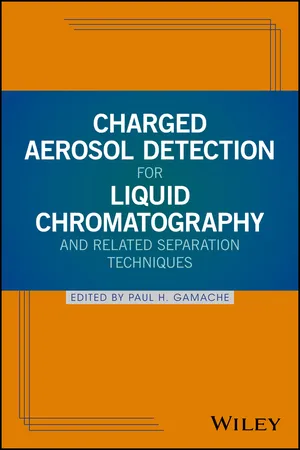
Charged Aerosol Detection for Liquid Chromatography and Related Separation Techniques
- English
- ePUB (mobile friendly)
- Available on iOS & Android
Charged Aerosol Detection for Liquid Chromatography and Related Separation Techniques
About This Book
The first book devoted exclusively to a highly popular, relatively new detection technique
Charged Aerosol Detection for Liquid Chromatography and Related Separation Techniques presents a comprehensive review of CAD theory, describes its advantages and limitations, and offers extremely well-informed recommendations for its practical use. Using numerous real-world examples based on contributors' professional experiences, it provides priceless insights into the actual and potential applications of CAD across a wide range of industries.
Charged aerosol detection can be combined with a variety of separation techniques and in numerous configurations. While it has been widely adapted for an array of industrial and research applications with great success, it is still a relatively new technique, and its fundamental performance characteristics are not yet fully understood. This book is intended as a tool for scientists seeking to identify the most effective and efficient uses of charged aerosol detection for a given application. Moving naturally from basic to advanced topics, the author relates fundamental principles, practical uses, and applications across a range of industrial settings, including pharmaceuticals, petrochemicals, biotech, and more.
- Offers timely, authoritative coverage of the theory, experimental techniques, and end-user applications of charged aerosol detection
- Includes contributions from experts from various fields of applications who explore CAD's advantages over traditional HPLC techniques, as well its limitations
- Provides a current theoretical and practical understanding of CAD, derived from authorities on aerosol technology and separation sciences
- Features numerous real-world examples that help relate fundamental properties and general operational variables of CAD to its performance in a variety of conditions
Charged Aerosol Detection for Liquid Chromatography and Related Separation Techniques is a valuable resource for scientists who use chromatographic techniques in academic research and across an array of industrial settings, including the biopharmaceutical, biotechnology, biofuel, chemical, environmental, and food and beverage industries, among others.
Frequently asked questions
Information
Section 1
Fundamentals of Charged Aerosol Detection
1
Principles of Charged Aerosol Detection
1.1 Summary
1.2 History and Introduction to the Technology
Table of contents
- Cover
- Title Page
- Table of Contents
- List of Contributors
- Preface
- Acknowledgment
- Section 1: Fundamentals of Charged Aerosol Detection
- Section 2: Charged Aerosol Detection of Specific Analyte Classes
- Section 3: Industrial Applications of Charged Aerosol Detection
- Index
- End User License Agreement